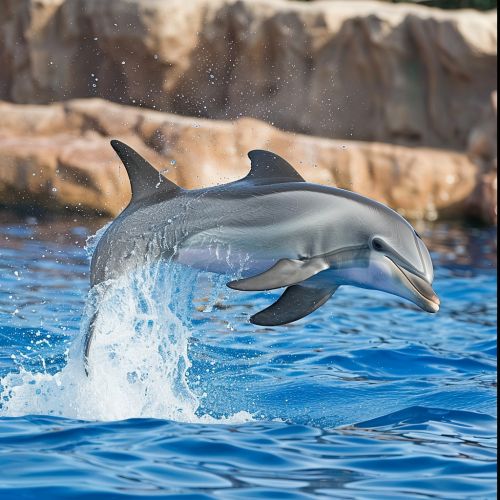Dolphins
Classification and Evolution
Dolphins are a group of aquatic mammals within the infraorder Cetaceans. They belong to the family Delphinidae, one of the 14 families of marine mammals that include whales, dolphins, and porpoises. Dolphins evolved around ten million years ago during the Miocene epoch.


Anatomy and Physiology
Dolphins have a streamlined fusiform body, adapted for fast swimming. The tail fin, called the fluke, is used for propulsion, while the pectoral fins together with the entire tail section provide directional control. The dorsal fin, in species that have one, provides stability while swimming.
Unlike most mammals, dolphins do not have hair, instead they are covered by a layer of smooth, thick skin which contains a blubber layer beneath it for insulation. Dolphin skin is renewed every two hours, which is about nine times faster than human skin.
Dolphins have a single blowhole located on the dorsal surface of the head. This blowhole is an adapted nose which has moved upwards to aid the dolphin's breathing while it remains submerged. Dolphins are voluntary breathers, who must consciously surface and open their blowholes to get air.
Dolphins have a unique dental pattern. Unlike humans, dolphins do not chew their food, they only use their teeth to grasp their prey. Therefore, their teeth are conical and sharp.
Echolocation
Dolphins are known for their ability to use echolocation, a method of sensing the environment by emitting sounds and listening for the echoes. Dolphins produce high frequency clicks via a structure in their forehead known as the 'melon'. The sound waves travel through the water and bounce back to the dolphin when they hit an object. The dolphin then interprets this echo to determine the object's shape, direction, distance, and even some aspects of the texture of the object.
Behavior and Communication
Dolphins are highly social animals, often living in pods of up to a dozen individuals. In places with a high abundance of food, pods can merge temporarily, forming a superpod; such groupings may exceed 1,000 dolphins.
Dolphins communicate using a variety of clicks, whistle-like sounds and body movements. They have been observed to teach, learn, cooperate, scheme, and even grieve. Dolphins also display culture, something long believed to be unique to humans (and possibly other primate species). In May 2005, a discovery in Australia found Indo-Pacific bottlenose dolphins (Tursiops aduncus) teaching their young to use tools.
Conservation
Many species of dolphins are threatened by human activities. The International Union for Conservation of Nature (IUCN) currently lists five dolphin species as endangered. Major threats to dolphins include fisheries bycatch, habitat degradation, and hunting. In addition, marine pollution, including noise, heavy metals, plastics, and other forms of waste, also pose a significant threat to dolphin populations worldwide.
See Also
- Cetacean Intelligence - Marine Conservation - Aquatic Ecosystems
